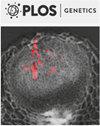The transcription factor RUNT-like regulates pupal cuticle development via promoting a pupal cuticle protein transcription
IF 3.7
2区 生物学
Q1 Agricultural and Biological Sciences
引用次数: 0
Abstract
Holometabolous insects undergo morphological remodeling from larvae to pupae and to adults with typical changes in the cuticle; however, the mechanism is unclear. Using the lepidopteran agricultural insect转录因子RUNT-like通过促进蛹的角质层蛋白转录调控蛹的角质层发育
全代谢昆虫从幼虫到蛹再到成虫都会经历形态重塑,其角质层会发生典型的变化,但其机制尚不清楚。我们以鳞翅目农业昆虫棉铃虫(Helicoverpa armigera)为模型,揭示了转录因子 RUNT-like(由 Runt-like 编码)通过促进蛹角质层蛋白基因(HaPcp)的表达来调控蛹角质层的发育。在幼虫的变态过程中,HaPcp在表皮和翅膀中高度表达,通过RNA干扰(RNAi)分析发现,HaPcp参与了蛹角质层的发育。Runt-like 在变态过程中也在表皮和翅膀中强烈上调。敲除 Runt-like 会产生与敲除 HaPcp 类似的现象,即腹部黄色包膜和翅膀无法形成。昆虫蜕皮激素 20-羟基蜕皮素(20E)通过 RUNT-like 上调 HaPcp 的转录。20E 通过核受体 EcR 和转录因子 FOXO 上调 Runt-like 的转录。在 20E 的调控下,RUNT-like 和 HaPCP 共同参与了蛹变态过程中的角质层发育。
本文章由计算机程序翻译,如有差异,请以英文原文为准。
求助全文
约1分钟内获得全文
求助全文
来源期刊

PLoS Genetics
生物-遗传学
CiteScore
8.10
自引率
2.20%
发文量
438
审稿时长
1 months
期刊介绍:
PLOS Genetics is run by an international Editorial Board, headed by the Editors-in-Chief, Greg Barsh (HudsonAlpha Institute of Biotechnology, and Stanford University School of Medicine) and Greg Copenhaver (The University of North Carolina at Chapel Hill).
Articles published in PLOS Genetics are archived in PubMed Central and cited in PubMed.
 求助内容:
求助内容: 应助结果提醒方式:
应助结果提醒方式:


